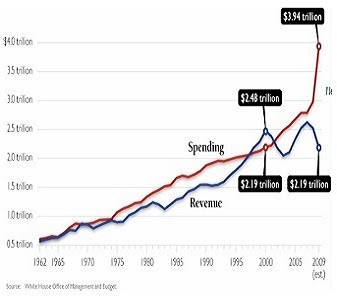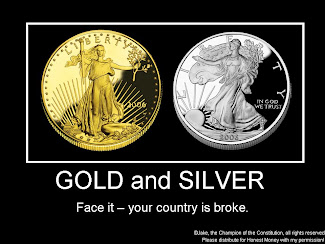There are two ways to conquer and enslave a nation. One is by the sword.. The other is by debt. - John Adams 1826I wanted to revisit an older post in order to unload a massive source of irritation. This was triggered by commentary by the widely read Charles Hugh Smith, who was speculating on whether or not "derivatives deleveraging" is causing a rally in the stock market. In addition, since my last discussion of this topic, I have seen several news reports which referred to system "deleveraging" and "consumer deleveraging." Hmmm....
This was yesterday's headline on Marketwatch after the consumer credit report was released:
Consumer credit surges again in December U.S. consumers increased their debt in December by a seasonally adjusted $19.3 billion, the Federal Reserve reported Tuesday. The increase is just below November's $20.4 billion pace which was the biggest gain in a decade. Monthly debt rose by a 9.4% pace in December, after a 9.9% pace in the prior month. The increase in consumer credit in December was much larger than expected by Wall Street economists LINKWhere the hell is the deleveraging to which everyone alludes? For the year, consumer credit rose 3.7%, the largest increase since 2007
Here's a chart of total non-financial/non-Government debt in our system (this would everything but banks, insurance companies, etc, Treasury debt and State/local Govt debt):
The last time around on this topic I showed Federal Govt debt and total consumer debt. The consumer debt for sure showed a very small decline over the 2 years but it was more than offset by the increase in Treasury debt. It can be argued convincingly that a majority of the consumer debt "decline" was simply an accounting game in which the banks wrote down some of the mortgage debt that was ultimately transferred to the Government and the Fed. The Fed transfer is of course back-stopped by the Treasury. In other words, consumer debt in Truth never really declined. I'm still scratching my head over why all these analysts and media morons keep referring to "deleveraging" in reference to the consumer...
Here's a timely quote from the latest issue of the Privateer:
From October to November 2011, US household borrowing on credit cards, car loans, student loans etc jumped 10 percent. This burst of “consumer spending” was welcomed by many as a sign of returning economic “health.” In reality, it is an infallible sign of growing desperation in the US middle class. This spike in borrowing, which includes a huge increase in borrowing from retirement plans, is being done simply for day to day expenses. The result so far has been the biggest one month increase in US consumer indebtedness in a decade. Without income growth, this cannot continue.
As for Charles Hugh Smith's reference to "derivatives deleveraging," it's utter nonsense and results from sloppy due diligence. By the last figures I saw, the amount OTC derivatives being held by Too Big To Fail banks increased by over 25% since the 2008 financial crisis. Supposedly the Dodd-Frank abortion was supposed to make the bank derivatives business more transparent and less risky, but the big banks are already finding ways around it - as predicted by this blog. In fact, I said at the time Dodd-Frank was being finalized that the legislation would actually enable more bank risk-taking because regulators and the public in general would carry on as if Dodd-Frank provided needed protections - which is does not. Dodd-Frank will ultimately end up costing the middle class taxpayer $100's of billions if not trillions after the next big round of bank bailouts from debt and derivatives disasters ensues. Do your god damn homework, Charles. I stopped reading him several years ago because I think his commentary has no value-added and his analysis and fact-checking sucks.
The Truth of the matter is that both domestically here in the U.S. and globally, the amount of outstanding obligations is going up at an increasing rate - it is accelerating. When you unwind all of the gimmicks being employed to mask part of this increase - like asset hypothecation/rehypothecation - the rate of increase is going parabolic. A global debt/liability bubble. It's truly frightening. The tautological "offset" to this frightening rate of debt accumulation will be BOTH the parabolic increase in the "de facto" money supply AND a parabolic increase in the price of gold/silver. I say "de facto" because I am referring to both the currency in circulation plus the amount of money made available by credit. The ECB balance sheet has spiked higher than the Fed balance sheet. Make no mistake, the Fed will correct that shortly in order to devalue the dollar in relation to the euro. That's why the big banks are record short the euro via futures. Japan is printing to infinity, as is China. It's going parabolic.
Given that we are now in the serious "bubble" phase of money printing and debt accumulation, it makes sense that the serious "bubble" phase for the rise in the price of gold and silver is still ahead of us.






![[Most Recent Quotes from www.kitco.com]](http://www.kitconet.com/images/sp_en_6.gif)








To your point....does he mean deleveraging via increased capital ? ie,
ReplyDeleteThe End of Wall Street As They Knew It
After surprisingly successful financial reform, public vilification, and politics that have turned against them, the Masters of the Universe are masters no longer.
As the banks jettison their trading arms, they’re being restrained by rules that force them to retain more capital. In December 2011, the Fed announced it would compel banks over the next few years to effectively double the amount of capital they hold on their books, a move that would curb leverage and, ultimately, profits. At the boom’s peak, banks like Lehman and Bear Stearns levered up 30, even 40, to 1. Under the new rules, banks would only be able to borrow $12 for every dollar they spend. In Europe, the rules are even stricter: British regulators have indicated that banks may have to hold as much as 20 percent on their books. �Everything that happened over the past 30 years comes back to the leveraging of the global economy,� a former Bear Stearns executive said, �and now that’s reversing.�
http://nymag.com/print/?/news/features/wall-street-2012-2/index6.html
No you should read his commentary from yesterday. He's saying that banks are selling credit protection on things like indexes that replicate Euro sovereign debt and then short equity indices to hedge. When the derivatives trade unwindes, they then have to go and buy the index to unwind their end. He's wrong. Not only is he wrong, the but overall level of CDS issuance is mushrooming every week.
ReplyDeleteThe tautological "offset" to this frightening rate of debt accumulation will be BOTH the parabolic increase in the "de facto" money supply AND a parabolic increase in the price of gold/silver. I say "de facto" because I am referring to both the currency in circulation plus the amount of money made available by credit.
ReplyDeleteIs your article saying in so many words what this says in 2 graphs?
Quite worrisome, especially his short timeline.
http://www.financeandeconomics.org/Articles%20archive/2011.12.17%20TMS-hypo.htm
It is except the Austrian TMS does not take into account the notion that currency-equivalent spending power created by debt issuance is really money supply until it's paid back. If there's default or write-downs, like in 2008, it ultimately converts into measured money supply, as defined by the M1/M2/etc. So I'm saying that the inflationary effect of debt on the system is the same a money printing until the debt is completely paid in full. Unless of course the debt is used to create positive net present value GDP growth. The economic exppansion "monetizes" the debt naturally. But the debt issuance going on now is used for consumption and Government welfare/defense - in all countries.
DeleteILLUSION OF RECOVERY – FEELINGS VERSUS FACTS
ReplyDeleteBernanke and his Wall Street puppet masters’ plan is actually quite simple. It’s essentially a confidence game. A confidence game (also known as a con, flim flam, gaffle, grift, hustle, scam, scheme, or swindle) is an attempt to defraud a group by gaining their confidence. The people who commit such tricks are often known as con men, con artists, or grifters. The con man often works with one or more accomplices called shills, who help manipulate the mark into accepting the con man’s plan. In a traditional confidence game, the mark is led to believe that he will be able to win money or some other prize by doing some task. The accomplices may pretend to be random strangers who have benefited from successfully performing the task. Bernanke and the 1% are the con men. They are attempting to defraud the 99% by convincing them their “solutions” will benefit them. The shills acting as accomplices are Wall Street bankers, bought off economists, politicians, journalists, and mainstream media pundits. You are the mark. The game has multiple facets but is based on more freely flowing low interest easy debt. The con man has reduced interest rates to zero at the behest of his puppet masters. The Wall Street accomplices offer enticing financing to the marks for big ticket items like automobiles, furniture and electronics. As the marks go further into debt, the Wall Street shills report record earnings ($26 billion from loan loss reserve accounting entries), consumer spending rises and GDP goes higher. The mainstream media accomplices dutifully report an improving economy. The government accomplices massage the employment and inflation data and declare a jobs recovery with no inflation. The marks are supposed to feel better about the future and spend even more borrowed money. This is what is considered a self-sustaining recovery by the psychopaths running this country.
http://www.theburningplatform.com/?p=28887
They can create all that debt out of thin air but they couldn't find this pittance...
ReplyDeleteJPMorgan Chase Caps Martin Luther King PR Campaign By Foreclosing on Civil Rights Activist
Now that campaign is turning into a public relations nightmare for the banking behemoth. Chase is now threatening to foreclose on 78-year old, Helen Bailey, a former Nashville area Civil Rights activist who stood up to police attack dogs, tear gas and fire hoses for her God given rights.
Ms. Bailey couldn’t keep up with her mortgage payments and attempted to refinance with another mortgage company and would work with her to let her stay in her home until she died. The only thing she asked from Chase was a $9000 principal write down.
Chase refused and now are threatening to foreclose and evict this hero of one of the darkest times of American history.
http://jessescrossroadscafe.blogspot.com/2012/02/jpmorgan-chase-caps-martin-luther-king.html
Everybody's borrowing....
ReplyDeleteHarbinger to Borrow $190M at 15% Interest
UBS Loan
The loan is backed by all of the fund’s assets, according to the people, including a 27 percent stake in Ferrous Resources Ltd., an iron-ore producer in Brazil. If any assets are sold, Jefferies gets paid first, according to the people, and the lender has the right to help sell some of the assets at an agreed upon minimum price.
http://www.bloomberg.com/news/2012-02-08/falcone-s-harbinger-said-to-borrow-190-million-from-jefferies-at-15-rate.html
On Track...to a Train Wreck
ReplyDeleteThe report calls for a change in bankruptcy laws.
In the survey, 81 percent of respondents said that potential clients with student loan debt have increased "significantly" or "somewhat" in the last four years.
And 95 percent of respondents reported that few student loan debtors have any chance of discharging what they owe through a bankruptcy proceeding because they have to prove "undue hardship" — a standard that is difficult to meet.
The total debt from student loans is about $1 trillion, about 14 times more than 15 years ago and well above the estimated total credit card debt of $798 billion.
...
The report urges a change in bankruptcy laws so that those burdened with student debt would be on the same footing as others in debt facing bankruptcy.
http://www.financialarmageddon.com/2012/02/on-trackto-a-train-wreck.html
wow...that's a lot of debt in this job market let alone a good one!
Dave, is it possible that "This spike in borrowing, which includes a huge increase in borrowing from retirement plans, is being done simply for day to day expenses" is actually an attempt by retirement plan holders to get some of their retirement funds safely into their own hands, rather than having them forcefully converted to the cough-safety of US govt debt-cough, at some point in the future???
ReplyDeleteWhen you say "borrowing" from retirement funds, that's only allowed for buying a primary residence and I think for medical expenses. I doubt that money even shows up because it's not really debt. People who take retirement fund money for living expenses have to cash out and pay the penalty plus any income taxes on that money. Same deal if you liquidate your IRA to get the money out of the system and into gold. Believe me, I already footed that tax expense LOL.
DeleteDave it still befuddles me on why my mining shares have done so poorly overall this past year or so after the big bounce of 2009. Maybe I am just a bad trader but then gold is up quite a bit....
ReplyDeleteGive them time. The mining shares are about as undervalued in relation to the price of gold/silver as at any time in the last 10 years. If you have cash to invest in good mining shares, do it. Then be patient.
ReplyDeleteThanks Dave. I have a mix of producers and royalty companies: FNV,SLW,PAAS,NGD,RIC,KGI,AUY,ANV,and GORO. Fingers crossed and I can hold no reason to day trade them.
DeleteI don't like PAAS, RIC, or AUY. Have never looked at FNV or KGI. GORO in my view is overvalued for what it is but the market/newsletters love it and it will hit new all-time highs before a lot of the other ones will. We own NGD and ANV in the fund and trade SLW.
DeleteTake look at EMXX and WS.TO and RPM.TO
I've liquidated two of my mining positions in the green this week and am averaging down others to wait for a rise, also putting more money in oil...
DeleteGiven that we are now in the serious "bubble" phase of money printing and debt accumulation, it makes sense that the serious "bubble" phase for the rise in the price of gold and silver is still ahead of us.
ReplyDeleteyou talking paper or physical... ;0)
LOL
DeleteBank of England adds another dose of QE
ReplyDeletehttp://www.marketwatch.com/story/bank-of-england-adds-another-dose-of-qe-2012-02-09?link=MW_story_latest_news
Face it folks its print or Die, got Gold you will wish you had. Buffet just said those holding Bonds will be living in the soup lines...Buffet is buying Gold obviously.
May you live in interesting times.
Gold is the only way to choke the corruption out...they're not going to do it on their own!
ReplyDeleteBill Black: On Why White Collar Crime is on the Rise, How to "Hotspot" Elite Financial Crimes, and Why Republicans and Democrats are Not Interested
On why Republicans and Democrats are not pursuing elite white collar crime: It would hurt campaign contributions. Finance is the leading source of campaign contributions for both parties.
http://www.capitalismwithoutfailure.com/2012/02/bill-black-and-dylan-ratigan-on-why.html